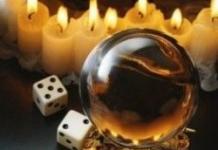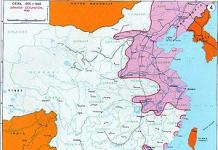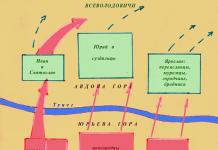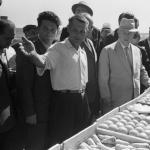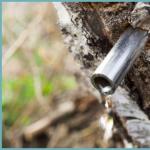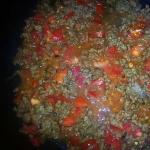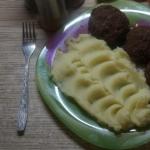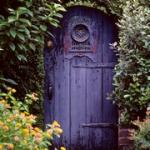Nikita Sergeevich Khrushchev was born on April 3 (15), 1894, in the village of Kalinovka, in the Kursk province, into a miner’s family.
In the summer he helped his family by working as a shepherd. In winter I studied at school. In 1908, he became an apprentice to a mechanic at the E.T. Bosse machine-building and iron foundry plant. In 1912 he began working as a mechanic at a mine. For this reason, in 1914 he was not taken to the front.
In 1918 he joined the Bolsheviks and took direct part in the Civil War. After 2 years he graduated from the army party school and participated in military events in Georgia.
In 1922 he became a student at the workers' department of the Dontechnikum in Yuzovka. In the summer of 1925, he became the party leader of the Petrovo-Maryinsky district of the Stalin district.
At the head of the USSR
Khrushchev took the initiative to remove and subsequently arrest L.P. Beria.
At the 20th Congress of the CPSU, he exposed the cult of personality of J.V. Stalin.
In October 1957, he took the initiative to remove Marshal G.K. Zhukov from the Presidium of the Central Committee and relieve him of his duties in the Ministry of Defense.
March 27, 1958 He was appointed Chairman of the Council of Ministers of the Soviet Union. At the 22nd Congress of the CPSU he came up with the idea of a new party program. She was accepted.
Foreign policy
Studying the short biography of Nikita Sergeevich Khrushchev , you should know that he was a prominent player on the foreign policy scene. He has repeatedly taken the initiative for simultaneous disarmament with the United States and an end to nuclear weapons testing.
In 1955 he visited Geneva and met with D. D. Eisenhower. From September 15 to 27, he visited the United States and spoke at the UN General Assembly. His bright, emotional speech went down in world history.
On June 4, 1961, Khrushchev met with D. Kennedy. This was the first and only meeting between the two leaders.
Reforms within the country
During Khrushchev's reign, the state economy turned sharply towards the consumer. In 1957, the USSR found itself in a state of default. Most citizens lost their savings.
In 1958, Khrushchev took the initiative against private farming. Since 1959, people living in the villages have been prohibited from keeping livestock. The personal livestock of collective farm residents was bought by the state.
Against the backdrop of mass slaughter of livestock, the situation of the peasantry worsened. In 1962, the “corn campaign” began. 37,000,000 hectares were sown, but only 7,000,000 hectares managed to mature.
Under Khrushchev, a course was set for the development of virgin lands and the rehabilitation of victims of Stalin's repressions. The principle of “permanence of personnel” was gradually implemented.
The heads of the union republics received more independence.
In 1961, the first manned space flight took place. In the same year, the Berlin Wall was erected.
Death
After being removed from power, N.S. Khrushchev lived in retirement for some time. He passed away on September 11, 1971. He was buried at the Novodevichy cemetery.
Personal life
Nikita Sergeevich Khrushchev was married 3 times. With my first wife , E.I. Pisareva, he lived in marriage for 6 years, until her death from typhus in 1920.
Khrushchev's great-granddaughter, Nina, now lives in the USA.
Other biography options
- In 1959, during the American National Exhibition, Khrushchev tried Pepsi-Cola for the first time, unwittingly becoming the advertising face of this brand, since the next day all publications in the world published this photo.
- Khrushchev’s famous phrase about “Kuzka’s mother” was translated verbatim. In the English version it sounded like “Mother of Kuzma,” which acquired a new, ominous connotation.
THE THAW WITH ELEMENTS OF REPRESSION
ON THIS TOPIC
The period of Khrushchev's reign has gone down in history as a thaw, but if we analyze everything that happened during the 11 years he was in power, the picture emerges, frankly speaking, not so good. Yes, Khrushchev’s merits in debunking the cult of personality and rehabilitating victims of mass repressions have certainly gone down in history. There were real breakthroughs during his reign: remember, for example, the flight of the first man into space or the flourishing of mass housing construction.
But, along with this, in the 60s, the most severe anti-religious campaign in the post-war period was organized in the USSR, the term “punitive psychiatry” appeared, and in Novocherkassk workers who took to the streets due to rising food prices were shot.
One can also recall the trials with the death penalty against currency traders and shopkeepers, whom Soviet propaganda called plunderers of socialist property, and the adoption of erroneous decisions in agriculture, the suppression of the uprising in Hungary in 1956, and the persecution of Boris Pasternak.
Finally, under Khrushchev, tensions between the USSR and the United States increased. The Cold War and the Cuban Missile Crisis almost led to a global nuclear disaster. The policy of the CPSU Central Committee under the leadership of Nikita Sergeevich on de-Stalinization led to a break with the communist regimes of Mao Zedong in China and Enver Hoxha in Albania.
So it is better to evaluate all the well-known merits of Khrushchev that are associated with his name through the prism of real historical events. The thaw, of course, went down in history, but the sediment, as they say, remained.

CORN – QUEEN OF FIELDS
The massive popularization of corn in agriculture during the years of Khrushchev's leadership of the country encountered several negative factors. As a result, Nikita Sergeevich was unable to make corn for the queen of the fields. The climatic conditions of the country were not taken into account: corn grows only in regions with a hot climate, so it was not possible to sow the entire country with it.
The story with corn began like this: in 1955, Khrushchev met the American farmer Roswell Garst, who spoke about the role of corn in American agriculture. Then the Soviet leader visited the United States, where he personally became acquainted with the crop of corn, which in terms of acreage and yield was far ahead of the traditional grain crops of the USSR.
It was decided to reorient agriculture towards this crop. It was planned to triple the growth rate of cattle by expanding corn crops; party delegates were sent to promote the crop to the north and east of the country.
By the early 1960s, a quarter of the arable land in the USSR was occupied by corn, for which fallow floodplain lands were also plowed up, providing especially valuable hay. As a result, corn yields were much lower than expected, and by the mid-1960s, corn plantings began to decline. Khrushchev's corn campaign failed.

FROM THE LORD'S SHOULDER
Khrushchev gave Crimea to Ukraine - this is what they usually say when recalling the events of 1954. In fact, no one gave anything to anyone. At that time, the Soviet Union was a single state and the borders between the republics existed only on the map. The formal transfer of the Crimean region to the Ukrainian SSR could not in any way influence public sentiment at that time, much less the emergence of interethnic problems.
In Khrushchev's decree, the legal reassignment of the region was explained by the commonality of the economy, territorial proximity and close economic and cultural ties between the Crimean region and the Ukrainian SSR. True, even now many historians are confident that this statement is not true.

According to some researchers, this transfer turned out to be a forced measure due to the difficult economic situation on the peninsula caused by post-war devastation and labor shortage after the deportation of the Crimean Tatars. According to other researchers, the statement about the difficult economic situation of Crimea before joining the Ukrainian SSR is not true - by 1954, the Crimean economy had already reached the pre-war level of development, and surpassed it in industrial development.
The version of Khrushchev's son Sergei is closest to the truth. He argued that the transfer of Crimea was necessary in order to legally and financially formalize the process of construction of the North Crimean Canal; it was supposed to provide water to the arid territories of the Kherson and Crimean regions with water intake from the Kakhovka reservoir, specially built in the lower reaches of the Dnieper. Since according to the project the canal passed through the territory of two Soviet republics, it was decided to ensure that the water artery was located exclusively in Ukraine.

KHRUSHCHEV'S BOOT
A photograph went around the whole world of Khrushchev knocking his shoe on the UN podium in New York. In fact, this is a skillful photomontage; Nikita Sergeevich did not knock on any shoes (at least on the podium in the main meeting room of the international organization), but this story has its own explanation and, in a slightly modified form, still took place.
On October 12, 1960, during a meeting of the 15th UN Assembly, the Hungarian issue was discussed, and Khrushchev, along with other members of the Soviet delegation, tried in every possible way to disrupt it. According to one version, things happened as follows: Khrushchev had on his feet that day not boots, but open shoes, like modern sandals.
During the speech of one Filipino speaker, Khrushchev took off his shoe and began to deliberately examine and shake it for a long time, raising it at head level, and also lightly tapped it on the table several times, as if trying to knock out a pebble that had allegedly rolled there. By these actions, the Soviet leader demonstrated that he was not interested in the report.

Khrushchev's son Sergei, who was present at that meeting, told a completely different story: a shoe from Khrushchev's foot flew into the crowd in front of the entrance to the meeting room, and then security brought it to him. He, tapping the table with his hand as a sign of disagreement with the speaker’s speech, began to help with his shoe.
Another witness, Life magazine photographer John Longard, voiced another version. According to him, Khrushchev certainly did not knock his shoes on the table, although he intended to do so. The leader of the Soviet country took off his shoe, put it on the table and showed with his free hand that he was going to hit the table with it. All the journalists in the room pointed their cameras at Khrushchev, awaiting his next actions, but he just put his shoe on his foot and left.

HAPPINESS IN KHRUSHCHEVKI
Millions of Soviet citizens said “thank you” to Nikita Sergeevich for improving their living conditions. The famous Khrushchev buildings began to be built en masse in the late 50s. For those who lived in barracks or communal apartments with one toilet for ten families, moving to a five-story panel house without an elevator or garbage chute seemed like a lifelong dream.
Small kitchenettes, in which, after purchasing a minimum set of furniture and a refrigerator, there was still room for two people; tiny bathrooms, where a person of a heavy build cannot turn around: a tiny corridor and thin walls through which you can hear your neighbor’s snoring. Today, such conditions seem not at all comfortable, but in the era of Khrushchev, moving to a new house was a real holiday for the whole family.

Of course, Khrushchev solved the housing problem at that time, but neither the authorities nor the architects then even thought about what would happen to these houses in 30-40 or 50 years. Their resource is now almost exhausted, which is why (so far only in Moscow) a decision was made to demolish Khrushchev-era buildings and resettle residents to new houses.
History still has not given an answer as to what happened more during the reign of Nikita Khrushchev - successes or downfalls. In terms of grandiose achievements, the Thaw was marked by a huge list of victories, but, on the other hand, many mistakes were made, which in fact became the prologue to Brezhnev’s stagnation and the gradual sliding of the country to the point of no return. After all, from the moment Khrushchev was removed from power until the collapse of the USSR, some 27 years passed: in a global historical context, these are seconds on the clock of eternity.
(born Perlmutter)
Years of life: April 5 (17), 1894 - September 11, 1971
First Secretary of the CPSU Central Committee from 1953 to 1964, Chairman of the Council of Ministers of the USSR from 1958 to 1964.
Hero of the Soviet Union, Three times Hero of Socialist Labor. The first laureate of the Shevchenko Prize.
Nikita Khrushchev biography
Nikita Sergeevich Khrushchev was born on April 17 (5), 1894 in the village of Kalinovka, Kursk province. Father, Sergei Nikanorovich, was a miner. Mother's name was Ksenia Ivanovna Khrushcheva. Nikita Khrushchev received his primary education at a parochial school.
In 1908, the future First Secretary began his career. He worked as a shepherd, mechanic, and boiler cleaner. At the same time, he was a member of trade unions and, together with other workers, participated in strikes.
In 1917, at the beginning of the Civil War, Nikita Khrushchev fought for the Bolsheviks on the Southern Front.
In 1918 he joined the Communist Party.
N. Khrushchev's first marriage ended tragically in 1920. His first wife, Efrosinya Ivanovna (before Pisarev’s marriage) died of typhus, leaving 2 children, Yulia and Leonid.
After finishing the war as a political commissar, N.S. Khrushchev returned to work at the mine in the Donbass. Soon he entered the working faculty of the Donetsk Industrial Institute.
In 1924 he married for the second time. His chosen one was Nina Petrovna Kukharchuk, a teacher of political economy at the party school. There are 3 children in this marriage: Rada, Sergei and Elena.

In 1928, after completing his studies, Khrushchev began to engage in party work. He was noticed by management and was sent to study at the Industrial Academy in Moscow.
Nikita Khrushchev years of party work
In January 1931 he began party work in Moscow.
In 1935 - 1938 held the position of 1st secretary of the Moscow regional  and city committees of the CPSU (b). At this time and later, already in Ukraine, he took an active part in organizing repressions.
and city committees of the CPSU (b). At this time and later, already in Ukraine, he took an active part in organizing repressions.
In January 1938, Nikita Khrushchev was appointed 1st Secretary of the Central Committee of the Communist Party of Ukraine and became a candidate member of the Politburo. In 1939 he was appointed a member of the Politburo.
During World War II N.S. Khrushchev was a member of the military councils of several fronts, was considered a political commissar of the highest rank, and led the partisan movement behind the front line.
On March 11, 1943, during one of the military battles, Leonid, the son of N. Khrushchev, a military pilot, went missing. Officially, he was considered killed in battle, but there are still many versions of his fate: from execution on the orders of Joseph Stalin to going over to the side of the Germans.
In 1943, N. Khrushchev received the military rank of lieutenant general. In 1944 - 1947 served as Chairman of the Council of People's Commissars (Council of Ministers) of the Ukrainian SSR.
In the post-war period, Nikita Sergeevich Khrushchev returned to Ukraine and led the republic's Communist Party.
In December 1949, he was transferred to Moscow and appointed 1st Secretary of the Moscow Party Committee and Secretary of the Central Committee of the All-Union Communist Party of Bolsheviks. In his new position, Nikita Sergeevich Khrushchev began to introduce his own initiatives: through consolidation, he reduced the number of collective farms by almost 2.5 times, and dreamed of creating so-called agro-cities instead of villages, in which collective farmers would live. It is published in the newspaper Pravda.
In October 1952, N.S. Khrushchev acted as a speaker at the 19th Party Congress.

Soviet statesman. First Secretary of the CPSU Central Committee from 1953 to 1964, Chairman of the Council of Ministers of the USSR from 1958 to 1964. Chairman of the Bureau of the CPSU Central Committee for the RSFSR from 1956 to 1964. Hero of the Soviet Union, three times Hero of Socialist Labor. Being the first secretary of the Moscow city committee and regional committee of the All-Union Communist Party, he was an ex officio member of the troika of the NKVD of the USSR in the Moscow region.
Date and place of birth: April 15, 1894, Kalinovka, Dmitrievsky district, Kursk province, Russian Empire.
Biography and activities
Born on April 17, 1894 in the village of Kalinovka, now Dmitrievsky district, Kursk region, in a working-class family.
He received his primary education at a parochial school. Since 1908, he worked as a mechanic, a boiler cleaner, was a member of trade unions, and participated in workers’ strikes. In the winter he attended school and learned to read and write, and in the summer he worked as a shepherd.
In 1908, at the age of 14, having moved with his family to the Uspensky mine near Yuzovka, Khrushchev became an apprentice mechanic at the E. T. Bosse Machine-Building and Iron Foundry Plant, from 1912 he worked as a mechanic at the mine and, as a miner, was not taken to the front in 1914 year.
After the February Revolution of 1917, he was elected to the Rutchenkovsky Council of Workers' Deputies, during the days of the Kornilov rebellion he became a member of the local Military Revolutionary Committee, and in December - chairman of the trade union of metalworkers in the mining industry.

During the Civil War he fought on the side of the Bolsheviks. In 1918 he joined the Communist Party.
In 1922, he entered the workers' faculty of the Dontechnikum, where he became the party secretary of the technical school, and in July 1925 he was appointed party leader of the Petrovo-Maryinsky district of the Stalin province.
In 1929, Nikita Sergeevich entered the Industrial Academy in Moscow, where he was elected secretary of the party committee.
In 1935-1938, Khrushchev was the first secretary of the Moscow and Moscow City Party Committees - MK and MGK VKP.
In January 1938, he was appointed first secretary of the Central Committee of the Communist Party of Ukraine. In the same year he became a candidate, and in 1939 - a member of the Politburo.
During the Great Patriotic War, Khrushchev was a member of the military councils of the Main Command of the troops of the South-Western direction, South-Western, Stalingrad, South-Eastern, Southern, Voronezh, 1st Ukrainian fronts; led work on organizing the partisan movement in Ukraine.
In October 1942, an order signed by Stalin was issued abolishing the dual command system and transferring commissars from command personnel to advisers. Khrushchev was in the front command echelon behind Mamayev Kurgan, then at the tractor factory.
In 1943, Khrushchev was awarded the military rank of “lieutenant general.”
In 1944-1947 - Chairman of the Council of People's Commissars (since 1946 - Council of Ministers) of the Ukrainian SSR. In December 1947, Khrushchev again headed the Communist Party of Ukraine, becoming the first secretary of the Central Committee of the Communist Party of Ukraine; He held this post until he moved to Moscow in December 1949.
On the last day of Stalin’s life, March 5, 1953, at the Joint Meeting of the Plenum of the CPSU Central Committee, the Council of Ministers and the Presidium of the USSR Armed Forces, chaired by Khrushchev, it was recognized as necessary that he concentrate on work in the Party Central Committee.
Khrushchev was the leading initiator and organizer of the removal from all posts and arrest of Lavrentiy Beria in June 1953.
In March 1958, Khrushchev took the post of Chairman of the Council of Ministers of the USSR. He was elected as a deputy of the Supreme Soviet of the USSR of the 1st-6th convocations.

On October 14, 1964, the Plenum of the CPSU Central Committee, organized in the absence of N. S. Khrushchev, who was on vacation in Pitsunda, relieved him of his post as First Secretary of the CPSU Central Committee “for health reasons.” The next day, by decree of the Presidium of the Supreme Soviet of the USSR, Khrushchev was relieved of his post as head of the Soviet government.
Leonid Brezhnev, who replaced Nikita Khrushchev as First Secretary of the CPSU Central Committee, according to the statements of the First Secretary of the Communist Party of Ukraine (1963-1972) Pyotr Efimovich Shelest, suggested that the Chairman of the KGB of the USSR V. E. Semichastny physically get rid of Khrushchev.
After this, N.S. Khrushchev retired. I recorded multi-volume memoirs on a tape recorder. He condemned their publication abroad.
Nikita Sergeevich Khrushchev died of a heart attack on September 11, 1971, at the age of 78. He was buried at the Novodevichy cemetery.
X Ruschevka
Houses built by Khrushchev (colloquially “Khrushchevka”) are Soviet standard series of residential buildings, massively built in the USSR from the late 1950s to the early 1980s. The name is associated with N.S. Khrushchev, during whose tenure as head of the USSR most of these houses were built. Refers to functionalist architecture. Most Khrushchev buildings were built as temporary housing. However, subsequently, due to the insufficient volume of housing construction, the period of their use was constantly increasing.
At the very beginning of the 1950s, in large industrial centers of the USSR (Moscow, Sverdlovsk, Kuzbass), entire blocks of four-story capital buildings were built, the structures of which were pre-fabricated at the factory.
A large-scale transition to new, progressive solutions in the field of construction began with the Resolution of the CPSU Central Committee and the USSR Council of Ministers of August 19, 1954.
The first Khrushchev-era apartment buildings were built in a short time in 1956–1958 around the village of Cheryomushki near Moscow (between modern Grimau, Shvernik, Dmitry Ulyanov streets and 60th Anniversary of October Avenue); The sixteen experimental four-story houses had mostly four entrances and were arranged according to a carefully thought-out plan by landscaping specialists and landscape architects.

On July 31, 1957, the Central Committee of the CPSU and the Council of Ministers of the USSR adopted a resolution “On the development of housing construction in the USSR,” which laid the foundation for new housing construction.
The construction of Khrushchev-era apartment buildings lasted from 1957 to 1985. The first revision of the Khrushchev projects was carried out in 1963-64. The construction of new modifications began after Khrushchev’s resignation in the second half of the 1960s, so such houses are classified as early Brezhnev buildings. In improved modifications, separate bathrooms and isolated rooms in two-room apartments appeared, the number of multi-room apartments increased, and high-rise buildings with an elevator and garbage chute appeared.
The abandonment of the construction of Khrushchev-era apartment buildings in favor of more comfortable housing began in the late 1960s and early 1970s.
About 290 million m2 were built in Russia. the total area of Khrushchev-era buildings, which is about 10 percent of the country’s total housing stock
“THE GREAT LEAP” BY NIKITA KHRUSHCHEV
In 1930, as a student at the Industrial Academy named after I.V. Stalin in Moscow, he is elected (that’s what it means to “have a language” - L.B.) secretary of the party committee of the Industrial Academy. Soon Khrushchev learned that his 29-year-old classmate Nadezhda Alliluyeva, although she did not advertise it, was - who would have thought? - the “first red lady” of the Soviet state, the wife of Comrade Stalin himself, who was already 22 years older than his wife.
Realizing that this is a unique chance for his career, Khrushchev uses the “energy and determination” noticed in him by senior political officer Strashnenko, as well as his ability to “fully understand the situation” and sets a course for rapprochement with Nadezhda Sergeevna, in whom he now sees him “golden key”, that magical “Open Sesame” that will lead him to the Corridors of the Supreme Power. And he was not mistaken in his calculations! He managed to get Nadezhda Alliluyeva to put in a good word for him (and maybe more than one) with the leader.
And from this moment Khrushchev’s rapid rise to political Olympus began. Since January 1931, Khrushchev was secretary of the Baumansky and then Krasnopresnensky district party committees of Moscow. And already in his “Personal File” a new piece of paper appears - “Special remark of the certification commission,” where our “round C student” is translated as “raised in party work to the highest group of political personnel.”
Professor of the Industrial Academy named after I.V. Stalin, Alexander Solovyov wrote in his diary in January 1931: “I and some others are surprised by Khrushchev’s rapid leap. I studied very poorly at the Industrial Academy. Now the second secretary, together with Kaganovich. But surprisingly close-minded and a big sycophant.”
The founders of “mass repressions”
One of the main instigators of “mass repressions” in the USSR, which after the notorious report at the 20th Congress will be referred to as “Stalinist repressions,” was Nikita Khrushchev himself. Back in January 1936, he stated in one of his speeches: “Only 308 people were arrested; for our Moscow organization this is not enough.” In his speech at the February-March (1937) Plenum of the Central Committee of the All-Union Communist Party of Bolsheviks, he said: “Sometimes a man sits, enemies swarm around him, almost climb on his feet, but he doesn’t notice and puffs up, supposedly in my apparatus there are no strangers. This is from deafness, political blindness, from an idiotic disease - carelessness.”
He is echoed by one of the first rehabilitated “victims” of political repression - Robert Eikhe, since 1929 the first secretary of the Siberian and West Siberian regional committees and the Novosibirsk city committee of the CPSU (b), a candidate member of the Politburo of the Central Committee. It was he who said: “We discovered many pests in Western Siberia. We uncovered the sabotage earlier than in other regions.”
By the way, it was precisely this excessive zeal, the massive scale of unfounded arrests, the encouragement of denunciation and falsification of criminal cases locally that was blamed on them, which is especially evident in the example of the same Trotskyist double-dealer Pavel Postyshev, who dissolved 30 district committees in the Kuibyshev region, whose members were declared enemies of the people and were repressed only because they did not see the image of a fascist swastika on the covers of student notebooks in the ornament! How could Postyshev not be repressed, despite all his past achievements?
In a word, our “hero”, the then “new nominee” Nikita Khrushchev, who with great joy took Kosior’s place in Ukraine and a place in the Stalinist Politburo, was the winner. Already in June 1938, that is, exactly six months after the appointment of Khrushchev, one of the delegates to the Congress of the Communist Party of Ukraine, the future head of the Sovinformburo, Colonel General A. Shcherbakov, noted: “The real merciless defeat of the enemies of the people in Ukraine began after the Central Committee sent Comrade Khrushchev to lead the Bolsheviks of Ukraine. Now the working people of Ukraine can be sure that the destruction of the agents of the Polish lords and German barons will be completed.”
N.S. KHRUSHCHEV AND ARCHITECTURE
The Stalinist style and the Khrushchev style remained from Soviet times. There is no Leninist style, no Brezhnevian style, no Gorbachevian style. Only Stalin and Khrushchev left behind a visible image of the country of their time, the image of a Soviet city.
The five-story building can be included in the Guinness Book of Records as the project with the largest number of copies. There are several million copies of these standard five-story buildings. They are located all over Russia, they were exported to China, to Vietnam: entire areas there were built up with such buildings. Almost the same five-story buildings exist in all major cities of the world. This project was invented in France in 1958 by engineer Lagutenko, and the first series of five-story buildings was called K-7.
Without an elevator, with a shared bathroom - small and cheap housing for the general public. The principle itself was simple: the building was manufactured at a factory using a conveyor belt method and assembled on site from parts, which is why there were so many copies. After purchasing the French project, it was remade to suit Soviet realities and, based on the basic one, about fifteen series of different five-story buildings were developed - with garbage chutes, balconies, and the like. On state farms and small towns, three- and four-story houses were built according to the same designs, simply without completing one or two floors.
In the early 60s, nine-story buildings also appeared. Actually, during Khrushchev’s time, only these two types of houses were built, with the exception, of course, of houses based on individual projects, including residential ones. Perhaps the last mass development throughout the Soviet Union took place during the time of Khrushchev. The main buildings are Khrushchev-esque: right down to bus stops, markets, cinemas. In small provincial towns it is clearly visible that the last time civilization came there was with Khrushchev. Many supporters of Stalin like to refute the assertion that it was Khrushchev that the Soviet people owed to Khrushchev for the massive construction of housing. At the same time, no one disputes that these five-story buildings solved the housing problem and provided Soviet citizens with separate apartments on a massive scale. But this category of people claims that Khrushchev only implemented a project that was born long before him, that is, under Stalin. And accordingly, Stalin should be called the father of this project.
The very renovation of architecture that took place was in line with advanced global trends. And it was expressed in the rejection of Stalinist neoclassicism. The same dominance of neoclassicism before the Second World War was observed in all totalitarian countries - in Germany, Italy and Japan, and even in many democratic countries. After the war, Europe experienced an incredible craving for renewal. And in fact, in all countries, starting from 1950, modernism began to win. This was especially clear in Berlin, where Stalinist buildings were being built in the Soviet zone, and panel houses were already growing behind the wall. This was the global trend. And in this sense, it was very correct that the USSR stood on the same rails as the whole world.
under Khrushchev, not only five-story buildings were built. Every political leader wants to leave something behind in architecture. After Stalin, the grandiose Moscow skyscrapers remained, and after Khrushchev, the Palace of Congresses and New Arbat.
Under Khrushchev there was the second wave of demolition of historical monuments after the 20s. He fought against vestiges of religion, closed and demolished monasteries. During the construction of the Palace of Congresses, the Chudov Monastery was destroyed, and New Arbat passed through residential areas.

X Rushchev and the Corn Campaign
In 1955, the First Secretary of the CPSU Central Committee N. S. Khrushchev met the American farmer Roswell Garst, who spoke about the role of corn in US agriculture and its advantages. Subsequently, during a trip to the USA, I had the opportunity to personally become acquainted with the American culture of growing corn, which in terms of acreage and yield was far ahead of the traditional grain crops of the USSR. In addition, corn provided valuable industrial raw materials, so it was decided to reorient USSR agriculture towards this crop.
It was planned to triple the growth rate of cattle in 1959-1965 by expanding corn crops. Party delegates were sent to the north and east to promote culture. By the early 1960s, a quarter of arable land was occupied by corn, for which fallow floodplain lands were also plowed up, providing especially valuable hay.
Corn harvests were much lower than expected and by the mid-1960s, corn plantings began to decline.
B from Khrushchev
A widely circulated story is that on October 12, 1960, during a meeting of the 15th UN General Assembly, the First Secretary of the CPSU Central Committee Nikita Khrushchev began to bang his shoe on the table
On that day, there was a discussion of the “Hungarian question,” and Khrushchev, along with other members of the Soviet delegation, tried in every possible way to disrupt it. According to the testimony of Khrushchev’s contemporaries, Anastas Mikoyan and Viktor Sukhodrev (Khrushchev’s personal translator, who was present at that meeting), things happened as follows: Khrushchev did not have a shoe, but open shoes (like modern sandals). During the speaker’s speech, Khrushchev took off his shoe and began to deliberately examine and shake it for a long time, raising it at head level, and also lightly tapped it on the table several times, as if trying to knock out a pebble that had allegedly rolled there. By these actions, Khrushchev demonstrated that he was not interested in the report.
Khrushchev’s son Sergei, who was present at that UN meeting, said that Khrushchev’s shoe came off in the crowd, and then security brought it to him. He, tapping on the table as a sign of disagreement with the performance, began to help with his shoe.
The next day, The New York Times published an article entitled “Khrushchev Knocks His Shoe on the Table.” It published a photograph showing Khrushchev and Gromyko, with a low shoe standing on the table in front of Nikita Sergeevich.
At the same meeting, Khrushchev called the Filipino speaker “a lackey of American imperialism,” confounding the translators.
From the memoirs of A. A. Gromyko:
“XV session of the UN General Assembly. Autumn 1960. The Soviet delegation there was headed by the head of government N.S. Khrushchev; British delegation - Prime Minister Macmillan.
The discussion was heated at times. Clashes between the Soviet Union and the leading countries of the NATO bloc were felt not only during discussions at the sessions, but also during the work of all bodies of the General Assembly - its many committees and subcommittees.
I remember Macmillan’s rather harsh speech on fundamental issues of relations between East and West. The delegates listened to him attentively. Suddenly, in the part of the speech where MacMillan used particularly harsh words against the Soviet Union and its friends, Khrushchev bent down, took off his shoe and began to bang it forcefully on the table at which he was sitting. And since there were no papers in front of him, the sound of the shoe hitting the wood was solid and was heard throughout the entire room.
This was a unique case in the history of the UN. We have to give Macmillan credit. He did not pause, but continued to read out his prepared speech, pretending that nothing special had happened.
Meanwhile, the General Assembly hall froze, watching this highly original and intense scene.
Soviet and American guards immediately formed a ring around the Soviet delegation. I was sitting to the right of Khrushchev, to the left was the permanent representative of the USSR to the UN, V. A. Zorin. They sat quietly and, of course, did not applaud.
Next door to the table was the table of the Spanish delegation. The diplomats sitting at this table ducked down a little, just in case.
Now it may look funny, but at that moment we were not laughing. The atmosphere in the hall was tense. One of the Spaniards with the rank of ambassador stood up, took a step forward, just in case, away from the boot, turned around and loudly shouted to Khrushchev in English:
Vi do not like yu! Vi do not like yu!
Nobody saw anything surprising in this, because at that time our relations with Spain were bad, and there were no diplomatic ones. The country was still ruled by Franco.
It may seem strange now, but there was not a single laughing person either in the delegate hall or in the public gallery. Everyone was just surprised, as if they were present at some incomprehensible ritual that excited the audience.”
Nikita Khrushchev and Disneyland
In 1951, the then leader of the Soviet Union, Nikita Khrushchev, flew to the United States for business purposes. But the trip was not limited to a meeting with American President Dwight Eisenhower. During the visit, Khrushchev also visited the famous Hollywood film studio 20th Century Fox, where he met many popular actors.
Now a small lyrical digression. The words spoken by the leader of the USSR a month before his visit to the USA: “Whether you like it or not, history is on our side. We will bury you” were instantly replicated by all the world’s media. By pronouncing them, Khrushchev only meant that socialism would outlive capitalism. But the head of the Hollywood film studio, Spyros Skouras, known for his anti-communist views, was struck by this phrase. And when he had the opportunity to talk face to face, he told the Soviet leader that it was not the USSR, but Los Angeles that did not want to bury someone, but would definitely take such a step if the need arose. Khrushchev regarded this speech as a mockery.
The situation became even more tense when the leadership of the United States, for security reasons, decided not to let Khrushchev into Disneyland.
The Soviet leader did not like this, to put it mildly. Nikita Sergeevich replied: “Are you hiding rockets at Disneyland? Or is there a cholera epidemic raging there? Maybe Disneyland has been taken over by bandits? Are your police not strong enough to deal with them? In a word, the trip was unsuccessful. And it only added tension to the relations of the world's dominant states.
Source – maxpark.com, biography.wikireading.ru, studopedia.ru, Wikipedia, publy.ru
Nikita Sergeevich Khrushchev - BIOGRAPHY, ACTIVITIES AND HOW THE LEADER RISE IN THOSE YEARS updated: October 24, 2017 by: website
Nikita Sergeevich Khrushchev is one of the most impulsive and controversial Soviet political leaders. He expanded the boundaries of freedom and earned a reputation as a fighter for democratization, condemning Stalin's terror, amnestying political prisoners, reducing repression and the influence of ideological censorship. Under him, a breakthrough into space was made and large-scale housing construction was launched, collective farmers got passports and an unprecedented openness to the world with the arrival of foreign tourists, artists, and students.But the name of the third head of the USSR (after Lenin and Stalin) is also associated with the suppression of the uprising against the pro-Soviet regime in Hungary, the shooting of protest participants in the former capital of the Don Army Novocherkassk, death sentences by courts for thieves of public property and black marketeers, the failed corn epic, the persecution of Nobel laureate Boris Pasternak, obscene language in the Manege at an exhibition of avant-garde artists, the breakdown of relations with China, the peak of Cold War tension with the United States.

The politician, who sought to build a better life for the people, but did not have deep encyclopedic knowledge and high culture (the old Bolsheviks called him “an ignoramus and a buffoon”), made a significant contribution to undermining the authority of Marxist philosophy in the world. “The first freak of the Soviet Union,” - this is the nickname Khrushchev earned from the mouths of our contemporaries.
Childhood
The future extraordinary party leader was born on April 15, 1894 in the village of Kalinovka, located 170 km from Kursk. He became the first-born in the peasant family of Sergei Nikanorovich (died 1938 from tuberculosis) and Ksenia Ivanovna (1872 - 1945) Khrushchev. Later they had a daughter, Irina. 
They worked tirelessly, but lived poorly. The boy received his primary education at a parochial school. At the age of 9, when he learned to count to thirty, his father decided that he had had enough of learning (“You’ll never have more than 30 rubles anyway,” his father told him), and sent him to work as a farm laborer for a landowner.
In the 1900s, their family went to work in Yuzovka (now Donetsk, Ukraine). They lived in a barracks in a workers’ village, where (according to his recollections) “dirt, crime and stench” reigned; they slept on two-tier bunks in rooms of 60-70 people. His father worked as a miner, his mother as a laundress, and Nikita as a steam boiler cleaner. The parents dreamed of saving money to buy a horse and return to the village, but they never succeeded.
According to the recollections of family friends, Ksenia Ivanovna considered her husband a doormat all her life and kept him under her thumb. She herself was a fighting woman, with character, while Sergei Nikanorovich was described as a kind man, but spineless.

Nikita Sergeevich once told his son-in-law that when he was little and grazing cows in a meadow, an unfamiliar old woman approached him and said: “Boy, a great future awaits you.” Little Nikita told this story to his mother, who from then on called him Tsar and boasted about him to her friends.
Labor activity
At the age of 14, the boy was hired as a mechanic's apprentice at the Bosse plant (now JSC Donetskgormash), where he became a member of the trade union and actively participated in strikes. At the age of 18, he began working as a mechanic at a coal mine in the village of Rutchenkovo. His mother insisted on this - she wanted her son to become one of the people, and not repeat the fate of his “worthless” father. 
Khrushchev is jokingly called the first Soviet biker. Having once seen a photograph of a motorcycle in his boss’s office, he welded his own iron horse from scraps of bicycle pipes and assembled the motor himself. The resulting vehicle remained on the road for 20 years and made Nikita the life of the party among local youth. At the same time, he never drank or smoked - his mother saved him from addictions.
At the age of 24, as soon as the revolution died down, Khrushchev joined the Communist Party. At the beginning of the Civil War, the young communist fled from Ukraine, fearing reprisals as a “Muscovite,” moved to Kalinovka to live with his grandfather, and then was drafted into the Red Army. He was a detachment commander, a battalion political commissar in the battles for the city of Tsaritsyn, and an instructor in the political department of the 9th Kuban Army.

After the war, he returned to the Rudchenkovo mine and from 1922 to 1925 he studied at the workers' faculty of the Don Technical School, where he was elected party secretary.
Career in the CPSU
An proactive and assertive fighter for Stalin’s cause in 1925, he headed the Petrovo-Maryinsky district committee of the Communist Party of Ukraine (Bolsheviks) in the Donbass. In 1928, he received his first high appointment - deputy head of the organizational department of the Central Committee of the Communist Party - and moved to Kharkov, where the republican government bodies were located. 
A year later, he became a student at the Industrial Academy in Moscow, enthusiastically took up the fight against the “right” there and soon became the party secretary of the educational institution. In 1932, he was approved as the second secretary of the city committee. He became the right hand of the first person of the committee, a close associate of Stalin, Lazar Koganovich. In 1934, he was already the successor to his boss as head of the Moscow State Committee, and a year later - the regional committee, although he never received a diploma from the academy.
On behalf of Koganovich, the loyal Stalinist controlled the progress of metro construction. In 1935, in honor of the successful completion of the first stage of an important facility, he was awarded his first Order of Lenin. During the same period, he demonstrated considerable zeal in organizing Stalin’s “purges” and in implementing plans to accelerate the pace of industrialization. By 1937, the politician entered the circle of the most influential people in the USSR. He was a deputy of the Supreme Council, a member of the Presidium and the first secretary of the Central Committee of the Communist Party of Ukraine.

Arriving in 1938 in Ukraine, which had experienced a terrible famine, and replacing the repressed Stanislav Kosior in the highest position, he began to form a new administrative apparatus of the republic to replace the one destroyed by mass repressions. Punitive expulsions did not stop under him, but were carried out on a lesser scale.
The most striking moments from Khrushchev's speeches
During the Second World War, the politician was a member of the military councils of a number of fronts. In 1943, he earned the high rank of lieutenant general. A year later, on the 50th anniversary of his birth, he was awarded the second Order of Lenin. He led the brutal suppression of the anti-Soviet partisan movement in the western regions of Ukraine, shooting more than 150 thousand and deporting about 200 thousand people out of the 3.5 million inhabitants of the region. He was the Prime Minister of the Ukrainian SSR, then the newly elected party secretary of the republic. As a member of the Politburo, he often visited the capital and met with the leader of the state.

Since 1949, the Ukrainian leader was transferred to Moscow. The head of the USSR instructed him to restore order in the capital's party organization and entrusted him with the post of secretary of the CPSU (b), although he did not have much respect for him. For example, during feasts at the leader’s dacha, where the most important issues of the state were discussed in a narrow circle, Joseph Vissarionovich forced his bald, short and overweight comrade-in-arms to dance the hopaka, bursting into laughter.
General Secretary of the CPSU Central Committee
Nevertheless, after Stalin passed away in 1953, the politician, whom many perceived as a poorly educated simpleton, managed to beat the all-powerful head of the special services Lavrenty Beria, Chairman of the Council of Ministers Grigory Malenkov and all other contenders in the fight for the throne, becoming the new sole party leader. 
During the years of being at the top of the political Olympus, Khrushchev did not build communism, as he promised, but he saved the country from many years of fear, rehabilitated more than 20 million people (though many of them posthumously), actively supported the development of science and technology, organizing the launch of the world's first nuclear power plant located in the Kaluga region, the first satellite and astronaut.
Among his successes in the agricultural sector are the lifting of the ban on collective farmers changing their place of residence, issuing them passports, cash wages, and the development of virgin lands. The positive results of his management also include the construction of free housing, the adoption of the “Peace Program,” cultural exchange with foreign countries, and a reduction of the army by a third.

However, he often acted inconsistently and too emotionally. For example, due to the ill-conceived military reform, many officers were left without housing and work, and the villagers, who under Stalin received 7 centners of grain as payment, began to receive money, but equivalent to only 3.7 centners. Collective farmers began to flee to the cities, and a shortage of bread arose. The country had to allocate 860 tons of gold to purchase grain from capitalist countries. Prices on the market increased by 13-17%, whereas under Stalin, prices traditionally decreased on April 1 of each year.
Nikita Khrushchev's speech at the UN (1960)
By 1964, the average annual growth rate of the economy had fallen from 11 to 5 percent. Due to the reduction in the number of collective farmers and low labor productivity, shortages in bread began; residents of the middle zone were forced to travel to the capital for food. At the same time, the USSR's gratuitous assistance to developing countries reached 3.5 billion rubles: India, Iraq, Syria, Ethiopia.

The big disadvantage of his activities was the destruction of individual farms (the number of livestock was halved, personal plots were reduced to 15-25 acres), the “corn madness”, the disappearance of white bread from stores, the intensification of the “Cold War”, the “Carribean crisis”, the cessation of payments for “Stalinist” bonds, an increase in retail prices, which provoked mass unrest, including the tragedy in Novocherkassk.

Khrushchev's policies led to the division of socialist countries into three blocs. Three “leaders” stood out: the USSR, Romania with Yugoslavia and China. Relations with the latter were spoiled after Khrushchev called Mao Zedong an “old galosh.”

Trying to create the image of a “peacemaker,” Khrushchev acted illogically: he brutally dispersed a rally in support of Stalin in Georgia, and no less brutally suppressed the uprising in Hungary in 1956. In 1957, he stopped payments on “Stalinist” bonds, which led to a 30% increase in prices for meat and dairy products. This led to popular unrest; in 1962, machine gun fire was opened on participants in a rally in Novocherkassk.
Another “invention” of Khrushchev is the famous five-story panel buildings. At one time, the Secretary General dispersed the USSR Academy of Architecture because they did not share Khrushchev’s opinion on the economic feasibility of building five-story buildings. In fact, with the money allocated for one “Khrushchev”, it was possible to build two 9-story buildings, saving on infrastructure - the costs of water supply and sewerage in 5-story buildings were higher.

Against the backdrop of many miscalculations, which led, instead of the promised abundance, to the threat of famine in the country, in 1964, the fighter against the cult of personality was removed from all positions at the October Plenum of the Central Committee. According to rumors, he said goodbye to his colleagues that the possibility of changing leadership without bloodshed was his main achievement. Khrushchev's successor was Leonid Brezhnev.
Personal life of Nikita Khrushchev
Khrushchev was married three times. His first chosen one was Efrosinya Pisareva, the sister of his fellow miner, whom he married before the revolution. In those years, Nikita Sergeevich, who received 40-50 rubles in gold per month, was provided with a government apartment and was exempt from military service as a highly qualified specialist, was known as an enviable groom. 
She died of typhus in 1919 while her husband was fighting at the front, and left her 25-year-old husband with her 3-year-old daughter Yulia and 2-year-old son Lenya in her arms. In 1922, Khrushchev became involved with Maria, a woman with a child from a previous marriage, but their relationship lasted little more than a year.
The third wife of the political leader and faithful life partner for 47 years was Nina Kukharchuk (born 1900), a teacher at the Yuzovsky party school, where they met and began living as a family in 1924. Nina Kukharchuk adequately represented the country on her husband’s trips abroad
They officially registered their marriage only after Nikita Sergeevich retired. In addition to two children from his first marriage, they raised three children together: daughters Radu and Elena and son Sergei.

The politician loved cinema, theater, folk and classical music. His favorite songs were Ukrainian songs performed by Ivan Kozlovsky, “I Amazing at the Sky” and “Black Eyebrows, Brown Eyes.”
Last years and death
After his resignation, the disgraced leader became a personal pensioner and lived in a dacha near Moscow, walking in the company of a shepherd named Arbat and the rook Kava (who fell out of the nest, fed by Khrushchev and became tame). The former general secretary communicated with security officers, talked with vacationers from a neighboring holiday home, and recorded his memories on a tape recorder (he was denied a stenographer to record his memoirs at the Central Committee). 
Later he became interested in photography and gardening. In the evenings, I often listened to broadcasts from Western radio stations “Liberty”, “Voice of America”, and the BBC, then expressing my opinion on the events taking place. He treated Academician Sakharov with sympathy, was sincerely indignant about attempts to rehabilitate Stalin, and was immensely shocked by Svetlana Alliluyeva’s flight from the country. It happened that he fell into depression, talked about the meaninglessness of his life, but then again, with a constant smile, he joked, walked, and told stories.

In 1970, Khrushchev’s health deteriorated and he suffered his first heart attack. A year later, he died in hospital from a massive myocardial infarction. The former head of the USSR was buried at the Novodevichy cemetery. The monument at his grave was sculpted by Ernst Neizvestny from white and black marble - as a symbol of the contradictory contribution of Nikita Khrushchev to the history of the country.



